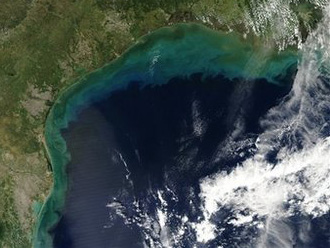
|  |  |  Editorials | Environmental | April 2009 Editorials | Environmental | April 2009  
Water Monitor Eyes Farm Runoff in Gulf of Mexico
 Garry Mitchell - Associated Press Garry Mitchell - Associated Press
go to original


| | This image provided by NASA shows sediments in the Gulf of Mexico taken by the Aqua satellite in Sept. 2002. The director of Global Water Watch hopes a new project that enlists middle and high school students will help reduce the farm runoff that is a growing pollution threat to the Gulf of Mexico. Nitrogen and phosphorus pollutants from the farms end up on a huge scale in the Gulf, where an 8,000-square-mile 'dead zone' forms annually off the Louisiana and Texas coasts as one result. (AP/NASA) |  |
Mobile, Ala. – A clean water expert at Auburn University hopes a new project that enlists middle and high school students will help reduce farm runoff that is a growing pollution threat to the Gulf of Mexico.

Bill Deutsch said colleagues in Veracruz, Mexico, are partners in the three-year effort to monitor water flowing into the Gulf.

Deutsch said his federally funded, $300,000 project will also help livestock producers in Alabama and in Veracruz develop management practices that can limit Gulf pollution, such as buffer zones and other methods of keeping livestock contaminants away from streams.

"You have got to start with some level of awareness," said Deutsch, a researcher in Auburn's Department of Fisheries and Allied Aquacultures.

Deutsch co-founded and manages the Alabama Water Watch program and is director of Auburn-based Global Water Watch, which coordinates a worldwide network of community-based water monitoring groups.

Deutsch said at least 20 middle and high school students and community groups in both Alabama and Veracruz will become certified in water monitoring to participate in the project. He said they will take water samples on a regular basis from streams feeding the Gulf, using portable test kits.

Deutsch said researchers will look at bacteria counts and other elements to determine whether a stream is getting better or worse. If a stream is polluted, they will attempt to trace that pollution back to its source.

He said the project, funded by the U.S. Environmental Protection Agency, is also "trying to get 'uplanders,' including livestock farmers, teachers and citizen water monitors, more aware of how nutrients come to the Gulf from great distances, and that land-use management makes a big difference."

Their target is agricultural runoff that drains from Gulf states and as far away as the U.S. Midwest, where the vast Mississippi River Basin is home to about half the nation's farms. Nitrogen and phosphorus pollutants from the farms end up on a huge scale in the Gulf, where one result is an 8,000-square-mile aquatic "dead zone" that forms annually off the Louisiana and Texas coasts.

U.S. Geological Survey research hydrologist Dale M. Robertson of Middleton, Wis., said agriculture isn't the only cause. Flooding and sewage treatment plants in urban areas also contribute to the dead zone.

"You can't just go after agriculture. It's a full suite of things," he said.

But there's mounting evidence that the mandated push to increase corn production — one of the most fertilizer-intensive crops for making ethanol — worsens water-quality problems within the states and in the Gulf, according to environmentalists.

Matt Rota, water resources director for the New Orleans-based Gulf Restoration Network, describes the dead zone as a "major national environmental problem" that will require more federal dollars for conservation programs.

Livestock farms already use federally approved techniques to prevent runoff because when manure is applied to farm fields as fertilizer, there is a potential for the waste to contaminate nearby waters.

Deutsch recommends a well-maintained streamside buffer zone of vegetation in pastures and near other livestock-holding facilities as a primary way to catch nutrients, sediment and pathogens before they get to the stream.

Other recommendations include use of alternative watering sites, fencing in key areas, and choosing the right kinds and mixes of pasture grass and other vegetation to reduce fertilizer use and guard against erosion.

Among Gulf states, Alabama alone has about 1 million head of cattle and produces more than a billion broiler chickens — all generating waste. Veracruz has an estimated 5 million head of cattle, 1.2 million hogs and 600,000 goats as well as a large number of trout farms using fertilizer.

Workshops and site visits will be held in both Alabama and Veracruz to emphasize the use of best management practices for water quality and on-farm water monitoring.

Deutsch's pollution project is part of the Gulf of Mexico Alliance of all five U.S. gulf states. Each of the five has a priority area: Alabama is focused on education and outreach; Florida on water quality for beaches and shellfish beds; Louisiana on wetland and coastal conservation and restoration, Texas on identifying and characterizing Gulf habitats; and Mississippi on reductions in nutrient inputs to coastal ecosystems. Mississippi and Louisiana also share the assignment of coastal community resilience.

Deutsch said Auburn has worked with colleagues in Veracruz for four years. His colleagues are primarily biologists and community educators from various governmental and non-governmental organizations.

"We share the same goals of protecting water quality and will be fostering exchanges of information and people to get the word out about protecting the Gulf," he said.

On the Net:

EPA Gulf program: http://gulfofmexicoalliance.org

Alabama Water Watch: http://www.aces.edu/dept/fisheries/aww/aww/index.php

USGA on Dead Zone: http://water.usgs.gov/nawqa/sparrow/nutrient_yields/index.html |

 |
|  |



